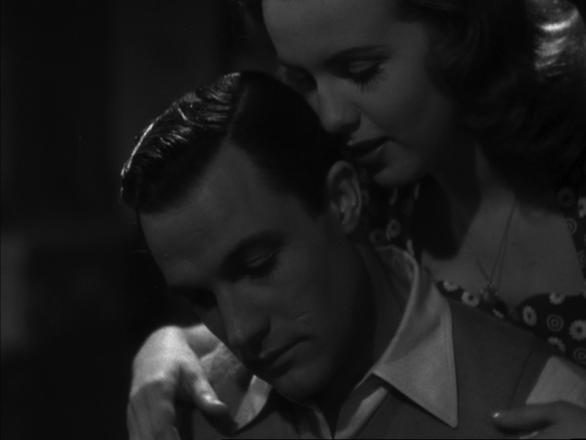Reviews
Robert Siodmak
USA, 1944
Credits
Review by Cullen Gallagher
Posted on 21 August 2012
Source DD Video DVD
Categories Gene Kelly
With a title like Christmas Holiday, and a cast that includes the adorably precocious singing sensation Deanna Durbin and song-and-dance man extraordinaire Gene Kelly, one might expect something of a yuletide Singin’ in the Rain. The actual film couldn’t be farther from this. Ironically and misleadingly titled, Christmas Holiday is a wartime noir fueled by that trinity of dark passions - sex, betrayal, and revenge - and underscored by the anticipated annihilation of World War II.
The film begins with a young soldier, played by Dean Harens, receiving word that his fiancée has married another man. Before heading overseas for the war, he hops an overnight flight to see her anyway, but bad weather grounds the plane in New Orleans. Passing time in a bar, he falls for singing strumpet Deanna Durbin. After they attend a midnight Christmas mass, she reveals that she is married to a very jealous murderer, played by Gene Kelly, who just happens to have escaped from jail. Suddenly, death by Nazis is looking pretty good to young Harens. If he can just survive this hellish Christmas night, maybe he can die in a less sordid manner.
Sounds good, right? Nice and bleak, with a dash of kink, two shakes of murder, and just a hint of existentialism, garnished with dense shadows courtesy of one of noir’s originators and most distinguished Hollywood practitioners, German émigré Robert Siodmak. Unfortunately, Christmas Holiday isn’t the perfect doomy present that one would hope it would be. Despite Siodmak’s expert direction, and surprisingly convincing dark turns from the usually lighthearted Durbin and Kelly, the script (written by Citizen Kane co-scribe Herman J. Mankiewicz, and based on a novel by W. Somerset Maugham), is an organizational nightmare. Divided into three present-day sequences separated by two clumsy and lengthy flashbacks, the script spends so much time setting up how and why Durbin and Harens’ characters got to this point in their lives that it forgets to spend ample time on their present condition. Too focused on exposition and allusive ways of circumventing the Production Code’s stringent morals (no easy feat for such a perverse story), Mankiewicz’s screenplay never fully reconciles its kinky ambitions with its compromised final form.
Film scholar Foster Hirsch, in his landmark study of noir The Dark Side of the Screen, perceptively noted that in Siodmak’s films, “the past is often a maze that has to be penetrated, its mysteries uncovered only gradually, by means of a complex web of intersecting viewpoints.” Hirsch is among the best noir scholars in the field, and in this one succinct sentence he nails the unique qualities that define Siodmak’s vision. However, when it comes to the flashback structure in Christmas Holiday, I can’t shake the feeling that Mankiewicz’s script should have been tighter, with more precise dialogue and punchier, more sharply defined plot points.
The initial thrust of the narrative focuses on Harens’ character; however, half-an-hour into the picture, the story derails with fifteen-minutes of backstory regarding Durbin and Kelly’s relationship: their idyllic courtship, the first signs of his lying-and-cheating personality, his gambling and the other nefarious activities that will be his downfall, as well as the incestuous influence of his domineering mother, Gale Sondergaard. This sudden shift kills the film’s momentum, and seems more like a literary device than one suited to cinema. Later, a second and even longer flashback (20 minutes) covers Kelly’s murder trial, his mother’s attempts to protect her son, and Durbin’s fall from grace. Though this is the meatiest part of the story, it is handled so flippantly that is loses much of its potential impact. Once the script is over the hump of that massive second flashback, the final minutes of the film are wasted on a rushed confrontation between Kelly, Durbin and Richard Whorf. After spending nearly the entirety of the film’s 90-minute runtime on exposition, there’s not much room to connect emotionally with the characters, or to feel much of anything when their fates are decided.
Yet while the script, and all its pretensions, may leave a lot to be desired, there is still much to admire about Christmas Holiday. Though his role is unlike the singin’ and dancin’ lovers Kelly is more famous for, this is probably my favorite role of his, and the only one that I fully believe him in. There’s no denying how perfectly Kelly nails his opening line, as he sneaks into his bedroom late at night and jokingly tries to explain his behavior to Durbin: “I do keep terrible hours, don’t I?” With that ear-to-ear, sleaze-ball smile, wide as a slit throat, he’s just the embodiment of the homme fatale, the man you can’t help but love even though you know he’s going to drag you down into the gutter with him.
Durbin, who is better known for her All-American girl-next-door charm and angelic opera voice - a mixture of low- and high-brow sensibilities - stretches out to prove her acting chops here in Christmas Holiday. Though at times some of the hardboiled lines seem stilted and inauthentic coming out of her mouth, Durbin delivers a stunningly subtle and multi-layered performance. Her deceptively simple and naïve personality belies the complexity and nuances of her character. Durbin is at once the femme fatale to Harens, leading him down a dark path to destruction; a wholesome victim for Kelly to corrupt; and a sexual competitor to Sondergaard for Kelly’s affection.
Though, on the surface, she often pretends to be ignorant of her husband’s criminal activities, Durbin is never as innocent as she would like to think she is. Like in Otto Preminger’s Laura (made the same year), flashbacks are notoriously unreliable and a narrator’s motivations always suspect. We cannot forget that Durbin is telling her story after attending a midnight mass on Christmas—she is seeking absolution and forgiveness, and in order to cleanse herself of the past she must first convince herself that she is the victim and in no way complicit in her downfall. Her seamless transition to prostitution and fast attachment to a soldier on leave, however, belie this self-image, and suggest that Durbin is more culpable than she would like to admit to herself.
Siodmak’s direction subtly enunciates many of the underlying themes of the picture. During their courtship, when Kelly leads Durbin to the dance floor, the camera closely follows them in an extended pan as the couple descends through densely shadowed corridors and stairs, foreshadowing not only their marriage (a walk down noir’s aisle), but also symbolically marking Durbin’s crossover from good- to bad-girl. The first meeting of Durbin and Sondergaard is a connective tracking shot that moves from woman to woman, linking and bringing them together like magnets, not only suggesting a sense of competition between them, but also a union of sorts, as though they are two parts to the same whole. Throughout the film, Siodmak often places Durbin and Sondergaard in the same frame, casting one face in light and the other in shadow, underscoring the yin-yang duality of the two women.
Considering all that Christmas Holiday has going for it - a deeply complex narrative, nuanced performances, and sumptuously detailed compositions - it’s a shame the movie ends on such a weak note. The final shot, of Durbin staring longingly into fake-looking clouds parting, seems so out of place that it suggests a campy joke, rather than a serious finale. It’s a rare tasteless moment from director Siodmak, and one of the regrettable facets that prevents Christmas Holiday from achieving the legendary status of contemporaneous noir films such as Laura or Double Indemnity, or even Siodmak’s own Phantom Lady. Still, Christmas Holiday is fascinating, if flawed, and one of the most unusual noir films in the canon.
More Gene Kelly
We don’t do comments anymore, but you may contact us here or find us on Twitter or Facebook.








